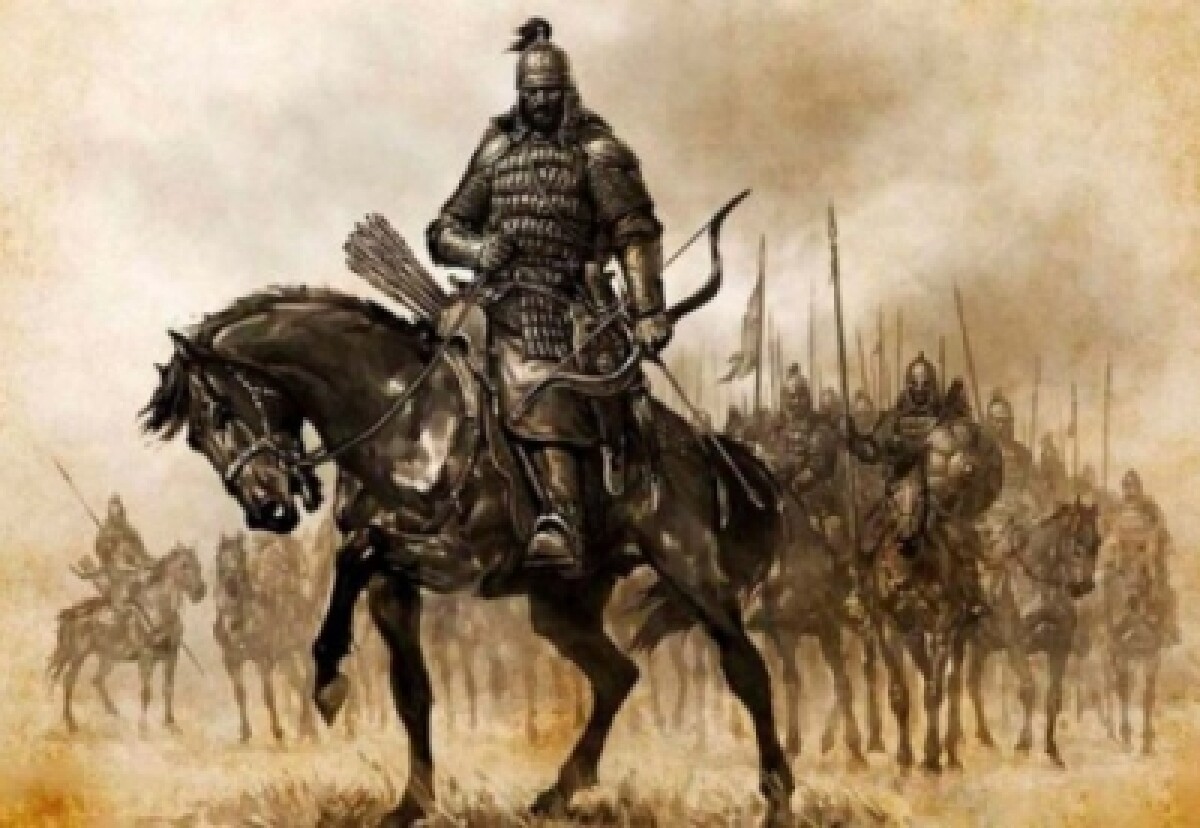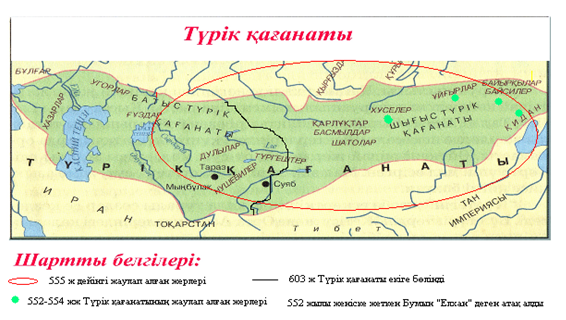
The Turkic Kaganate (551 – 603), which at its height stretched from Manchuria to the Northern Black Sea Coast, from the headwaters of the Yenisei river to the headwaters of the Amu Darya river, was later split into the Eastern (603-630) and Western Kaganates (533-657).
By the 560s, the Turkic Kaganate had diplomatic and economic relations with the Byzantium, Iran and China.
In 571, Istemi-Kagan moved military operations beyond the Volga, conquered the North Caucasus and came to the Kerch Strait, subjugating Alans, Bulgarians and other peoples of the Caucasus. In this way Istemi-Kagan prepared an indirect path to Byzantium, lying through Khorezm, the Volga region and the Caucasus. The intensity of contacts between the Turks and the Byzantines increased rapidly, over a period of 10 years the countries exchanged embassies and trade missions on a regular basis.
One of the pieces of the Western Turkic Kaganate was the tribal union of the Bulgarians, settled down between the Dniester river and the Danube river. Emperor Heraclius had very close and friendly relations with the Bulgarian Khan Kubrat (605-655). Kubrat khan grew up with Heraclius in Constantinople in the Imperial Palace and was baptized at the age of 12.
Such an ally, threateningly hanging over the northeastern border of the Avar Kaganate, immediately began to restrain the Avars. In 602, the Avars could not keep the Black Sea coast under their control.
The wars between Byzantium and Iran for supremacy in Anterior Asia (or its other name “West Asia”) took place in the V – VII centuries. Byzantium inherited the traditional military confrontation with the Persians from the Roman Empire. It is worth noting that Persia and the Eastern Roman Empire did not consider war as a war of political systems. Both sides saw war with each other as a battle between “their” world religions: Christianity and Zoroastrianism. Each side fought not just to have more territory or toll, but for the ultimate triumph of Universal and Absolute Truth. The capture of Jerusalem is an excellent example, demonstrating the true essence of the Iranian-Byzantine war.
Heraclius constantly emphasized the religious character of the war, and his permanent adviser and close friend Patriarch Sergey (610-638) supported him in this idea. Justinian waged religious wars with the hands of hired barbarians-federates, who were neither Christians nor Arians. The army of Heraclius consisted of the indigenous peoples of the Empire, who embraced the united Chalcedon faith. The army went to the war with the Persians, carrying in front of them the icon of Jesus Christ with the Virgin Mary. It was an army that was united by a sense of patriotism and a common ideology.
Toward the end of the war, both the Sasanian Iran and Byzantium, in the hope of securing an essential benefit, decided to turn to the search for allies. So, soon the Sassanids achieved an alliance agreement with the Avar Kaganate, and Byzantium with the Western Turkic Kaganate, who had a rather strained relationship with Iran and with the Avars.
In 627, Heraclius, having entrusted military operations against Shahan to his brother Theodore, moved to an ancient kingdom of Lazica, which is now located in the Western Georgia. Not far from Tbilisi, he met with the leader of the West-Turkic (or so-called “Khazar”) Kaganate, Ziebel, according to the Byzantine sources (Tong Yabghu - according to the Chineese sources, Jebu Kagan – according to the Russian-language sources) and for the first time in the history of the Second Rome entered into an alliance with him. Heraclius promised to give his daughter Eudoxia Epiphania for the Khazar kagan, if he would help Byzantium to defeat the Persians.
Located on the caravan road that connected East Asia with the Mediterranean countries, on the Silk Road, Tbilisi was considered inaccessible to the enemy siege.

The siege of Tbilisi lasted two months. The catapults of the Byzantians bombarded the city walls. Bags of stones and sand, thrown into the Kura River, changed the course of the river and washed away part of the fortress, but did not open the city gate. Emperor Heraclius persistently proposed a lifting of the blockade and moving deep into the Sassanian Iran’s territory. It could have happened if the besieged, seeing the futile attempts of the enemies, would not make fun of the combined forces of Heraclius, the Byzantine Emperor, and those of a West-Turkic (called “Khazar”) leader.
In the “History of the Country of Aluank”, written by the 7th century Armenian historian Movses Kaghankatvatsi, mocking took place. It is described as follows.
The Georgians carried a pumpkin on the wall and painted the face of the Khazar Kagan on it: there were thin lines instead of eyebrows, bare chin, scanty whiskers and very big nostrils. Then they shouted: “Here is Your Kagan!”. They took their spears and in front of combined forces of Heraclius and the Khazar Kagan, Ziebel began to stab the pumpkin.
After such a prank, the seizure of the city became for offended rulers a matter of principle. Heraclius nevertheless moved further, taking with him 40 thousand Khazar soldiers. And the Khazar Kagan, Ziebel remained to seize the city. According to some data, he fulfilled the task at a time, when Heraclius was in the Gardaban region (40 km from Tbilisi). But, according to a historian and an author of “History of the Country of Aluank” Movses Kaghankatvatsi, after parting with Heraclius, the Khazar Kagan returned home. He again laid siege to Tbilisi during his next campaign to Transcaucasia, took place next year, when the Iran-Byzantine war was already over.
During the siege of Tiflis (the old name of the city of Tbilisi), the Persian, the head of the garrison, shouted to Heraclius that he had a “goat’s beard and neck of an angry goat”. To this, Heraclius shouted in response that the “Western goat” came to break off the horns of “the Eastern sheep”. Indeed, that year, Heraclius finally crushed the power of the Sassanids in the great battle for Nineveh, which became the prelude to the conquest of Iran by the Arabs. Both city chiefs were captured. They were deprived of their eyes and their mouths were filled with coins. Then they had been skinned alive. Their skins were filled with hay and sent to Heraclius as a trophy.

